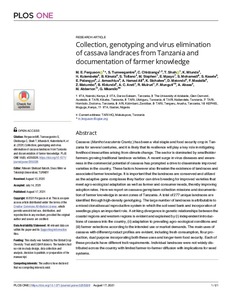| dc.contributor.author | Ferguson, M. |
| dc.contributor.author | Tumwegamire, S. |
| dc.contributor.author | Chidzanga, C. |
| dc.contributor.author | Shah, T. |
| dc.contributor.author | Mtunda, K. |
| dc.contributor.author | Kulembeka, H. |
| dc.contributor.author | Kimata, B. |
| dc.contributor.author | Tollano, S. |
| dc.contributor.author | Stephen, M. |
| dc.contributor.author | Mpayo, E. |
| dc.contributor.author | Mohamedi, S. |
| dc.contributor.author | Kasele, S. |
| dc.contributor.author | Palangyo, E. |
| dc.contributor.author | Armachius, J. |
| dc.contributor.author | Ali, A.H. |
| dc.contributor.author | Sichalwe, K. |
| dc.contributor.author | Matondo, D. |
| dc.contributor.author | Masisila, F.F. |
| dc.contributor.author | Matumbo, Z. |
| dc.contributor.author | Kidunda, B. |
| dc.contributor.author | Arati, A.C. |
| dc.contributor.author | Muiruri, R. |
| dc.contributor.author | Munguti, F. |
| dc.contributor.author | Abass, A. |
| dc.contributor.author | Abberton, M. |
| dc.contributor.author | Mkamilo, G. |
| dc.date.accessioned | 2021-09-27T12:32:22Z |
| dc.date.available | 2021-09-27T12:32:22Z |
| dc.date.issued | 2021 |
| dc.identifier.citation | Ferguson, M., Tumwegamire, S., Chidzanga, C., Shah, T., Mtunda, K., Kulembeka, H., ... & Mkamilo, G. (2021). Collection, genotyping and virus elimination of cassava landraces from Tanzania and documentation of farmer knowledge. PloS One, 16(8), e0255326: 1-21. |
| dc.identifier.issn | 1932-6203 |
| dc.identifier.uri | https://hdl.handle.net/20.500.12478/7258 |
| dc.description.abstract | Cassava (Manihot esculenta Crantz.) has been a vital staple and food security crop in Tanzania for several centuries, and it is likely that its resilience will play a key role in mitigating livelihood insecurities arising from climate change. The sector is dominated by smallholder farmers growing traditional landrace varieties. A recent surge in virus diseases and awareness in the commercial potential of cassava has prompted a drive to disseminate improved varieties in the country. These factors however also threaten the existence of landraces and associated farmer knowledge. It is important that the landraces are conserved and utilized as the adaptive gene complexes they harbor can drive breeding for improved varieties that meet agro-ecological adaptation as well as farmer and consumer needs, thereby improving adoption rates. Here we report on cassava germplasm collection missions and documentation of farmer knowledge in seven zones of Tanzania. A total of 277 unique landraces are identified through high-density genotyping. The large number of landraces is attributable to a mixed clonal/sexual reproductive system in which the soil seed bank and incorporation of seedlings plays an important role. A striking divergence in genetic relationships between the coastal regions and western regions is evident and explained by (i) independent introductions of cassava into the country, (ii) adaptation to prevailing agro-ecological conditions and (iii) farmer selections according to the intended use or market demands. The main uses of cassava with different product profiles are evident, including fresh consumption, flour production, dual purpose incorporating both these uses and longer-term food security. Each of these products have different trait requirements. Individual landraces were not widely distributed across the country with limited farmer-to-farmer diffusion with implications for seed systems. |
| dc.description.sponsorship | Global Crop Diversity Trust |
| dc.description.sponsorship | CGIAR Donors |
| dc.format.extent | 1-21 |
| dc.language.iso | en |
| dc.subject | Cassava |
| dc.subject | Food Security |
| dc.subject | Climate Change |
| dc.subject | Genotypes |
| dc.subject | Livelihoods |
| dc.subject | Disease Control |
| dc.subject | Genetic Diversity |
| dc.title | Collection, genotyping and virus elimination of cassava landraces from Tanzania and documentation of farmer knowledge |
| dc.type | Journal Article |
| cg.contributor.crp | Agriculture for Nutrition and Health |
| cg.contributor.crp | Genebanks |
| cg.contributor.crp | Roots, Tubers and Bananas |
| cg.contributor.affiliation | International Institute of Tropical Agriculture |
| cg.contributor.affiliation | The University of Adelaide |
| cg.contributor.affiliation | Tanzania Agricultural Research Institute |
| cg.contributor.affiliation | Kenya Plant Health Inspectorate Services |
| cg.coverage.region | Africa |
| cg.coverage.region | East Africa |
| cg.coverage.country | Tanzania |
| cg.coverage.hub | Eastern Africa Hub |
| cg.coverage.hub | Central Africa Hub |
| cg.coverage.hub | Headquarters and Western Africa Hub |
| cg.researchtheme | Biometrics |
| cg.researchtheme | Biotech and Plant Breeding |
| cg.identifier.bibtexciteid | FERGUSON:2021 |
| cg.isijournal | ISI Journal |
| cg.authorship.types | CGIAR and developing country institute |
| cg.iitasubject | Agronomy |
| cg.iitasubject | Cassava |
| cg.iitasubject | Climate Change |
| cg.iitasubject | Disease Control |
| cg.iitasubject | Food Security |
| cg.iitasubject | Livelihoods |
| cg.iitasubject | Plant Breeding |
| cg.iitasubject | Plant Diseases |
| cg.iitasubject | Plant Health |
| cg.iitasubject | Plant Production |
| cg.journal | PLOS ONE |
| cg.notes | Open Access Journal; Published online: 17 Aug 2021 |
| cg.accessibilitystatus | Open Access |
| cg.reviewstatus | Peer Review |
| cg.usagerightslicense | Creative Commons Attribution 4.0 (CC BY 0.0) |
| cg.targetaudience | Scientists |
| cg.identifier.doi | https://dx.doi.org/10.1371/journal.pone.0255326 |
| cg.iitaauthor.identifier | Morag Ferguson: 0000-0002-7763-5173 |
| cg.iitaauthor.identifier | Silver Tumwegamire: 0000-0003-2820-6337 |
| cg.iitaauthor.identifier | Adebayo Abass: 0000-0003-1376-3608 |
| cg.iitaauthor.identifier | Michael Abberton: 0000-0003-2555-9591 |
| cg.futureupdate.required | No |
| cg.identifier.issue | 8: e0255326 |
| cg.identifier.volume | 16 |

